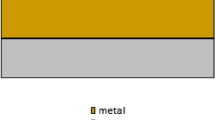Abstract
Short fibre reinforced metal matrix composites (MMC) are studied here to investigate the possibility that a cavitation instability can develop in the metal matrix. The high stress levels needed for a cavitation instability may occur in metal–ceramic systems due to the constraint on plastic flow induced by bonding to the ceramics that only show elastic deformation. In an MMC the stress state in the metal matrix is highly non-uniform, varying between regions where shear stresses are dominant and regions where hydrostatic tension is strong. An Al–SiC whisker composite with a periodic pattern of transversely staggered fibres is here modelled by using an axisymmetric cell model analysis. First the critical stress level is determined for a cavitation instability in an infinite solid made of the Al matrix material. By studying composites with different distributions and aspect ratios of the fibres it is shown that regions between fibre ends may develop hydrostatic tensile stresses high enough to exceed the critical level for a cavitation instability. For cases where a void is located in such regions it is shown that unstable cavity growth develops when the void is initially much smaller than the highly stressed region of the material.
Similar content being viewed by others
References
McDanels D.L.: Analysis of stress–strain, fracture, and ductility behavior of aluminum matrix composites containing discontinuous silicon carbide reinforcement. Metall. Trans. A 16, 1105–1115 (1985)
Zok F., Embury J.D., Ashby M.F., Richmond O. et al.: The influence of pressure on damage evolution and fracture in metal–matrix composites. In: Andersen, S.I. (ed.) Mechanical and Physical Behaviour of Metallic and Ceramic Composites, pp. 517–526. Risø National Laboratory, Denmark (1988)
Mummery P., Derby B.: The influence of microstructure on the fracture behavior of particulate metal matrix composites. Mater. Sci. Eng. A 135, 221–224 (1991)
Christman T., Needleman A., Nutt S., Suresh S.: On microstructural evolution and micromechanical modelling of deformation of a whisker-reinforced metal–matrix composite. Mater. Sci. Eng. A 107, 49–61 (1989)
German R.M., Bose A.: Fabrication of intermetallic matrix composites. Mater. Sci. Eng. A 107, 107–116 (1989)
Needleman A., Nutt S.R., Suresh S., Tvergaard V.: Matrix, reinforcement and interfacial failure. In: Suresh, S., Mortensen, A., Needleman, A. (eds.) Fundamentals of Metal Matrix Composites, pp. 233–250. Butterworth-Heinemann, Boston, MA (1993)
Nutt S.R., Needleman A.: Void nucleation at fiber ends in Al–SiC composites. Scr. Metall. 21, 705–710 (1987)
Tvergaard V.: Effect of fibre debonding in a whisker-reinforced metal. Mater. Sci. Eng. A 125, 203–213 (1990)
Tvergaard V.: Model studies of fibre breakage and debonding in a metal reinforced by short fibres. J. Mech. Phys. Solids 41, 1309–1326 (1993)
Tvergaard V.: Fibre debonding and breakage in a whisker-reinforced metal. Mater. Sci. Eng. A 190, 215–222 (1995)
Tvergaard V.: Breakage and debonding of short brittle fibres among particulates in a metal matrix. Mater. Sci. Eng. A 369, 192–200 (2004)
Levy A., Papazian J.M.: Tensile properties of a short fiber-reinforced SiC/Al composite: Part II. Finite element analysis. Metall. Trans. 21A, 411–420 (1990)
Hom C.L.: Three-dimensional finite element analysis of plastic deformation in a whisker-reinforced metal matrix composite. J. Mech. Phys. Solids 40, 991–1008 (1992)
Bishop R.F., Hill R., Mott N.F.: The theory of indentation and hardness tests. Proc. Phys. Soc. 57, 147–159 (1945)
Hill R.: The Mathematical Theory of Plasticity. Clarendon Press, Oxford (1950)
Huang Y., Hutchinson J.W., Tvergaard V.: Cavitation instabilities in elastic–plastic solids. J. Mech. Phys. Solids 39, 223–241 (1989)
Tvergaard V., Huang Y., Hutchinson J.W.: Cavitation instabilities in a power hardening elastic–plastic solid. Eur. J. Mech. A/Solids 11, 215–231 (1992)
Niordson C.F., Tvergaard V.: Size-effects on cavitation instabilities. Trans. ASME E J. Appl. Mech. 73, 246–253 (2006)
Legarth B.N., Tvergaard V.: 3D analyses of cavitation instabilities accounting for plastic anisotropy. ZAMM 90, 701–709 (2010)
Kennedy T.C., Puttapitukporn T., Kassner M.E.: Dynamic effects on cavitation instabilities in solids. Acta Mech. 165, 73–85 (2003)
Ball J.M.: Discontinuous equilibrium solutions and cavitation in nonlinear elasticity. Philos. Trans. R. Soc. Lond. A 306, 557–610 (1982)
Horgan C.O., Abeyaratne R.: A bifurcation problem for a compressible nonlinearly elastic medium: growth of a microvoid. J. Elast. 16, 189–200 (1986)
Horgan C.O., Polignone D.A.: Cavitation in nonlinearly elastic solids: a review. Appl. Mech. Rev. 48, 471–485 (1995)
Ashby M.F., Blunt F.J., Bannister M.: Flow characteristics of highly constrained metal wires. Acta Metall. 37, 1847–1857 (1989)
Tvergaard V.: Studies of void growth in a thin ductile layer between ceramics. Comput. Mech. 20, 186–191 (1997)
Hutchinson J.W. et al.: Finite strain analysis of elastic–plastic solids and structures. In: Hartung, R.F. (ed.) Numerical Solution of Nonlinear Structural Problems, pp. 17. ASME, New York (1973)
Tvergaard V.: Effect of thickness inhomogeneities in internally pressurized elastic–plastic spherical shells. J. Mech. Phys. Solids 24, 291–304 (1976)
Tvergaard V.: On cavitation instabilities with interacting voids. Eur. J. Mech. A/Solids 32, 52–58 (2012)
Author information
Authors and Affiliations
Corresponding author
Rights and permissions
About this article
Cite this article
Tvergaard, V. Cavitation instabilities between fibres in a metal matrix composite. Acta Mech 227, 993–1003 (2016). https://doi.org/10.1007/s00707-015-1511-3
Received:
Revised:
Published:
Issue Date:
DOI: https://doi.org/10.1007/s00707-015-1511-3




